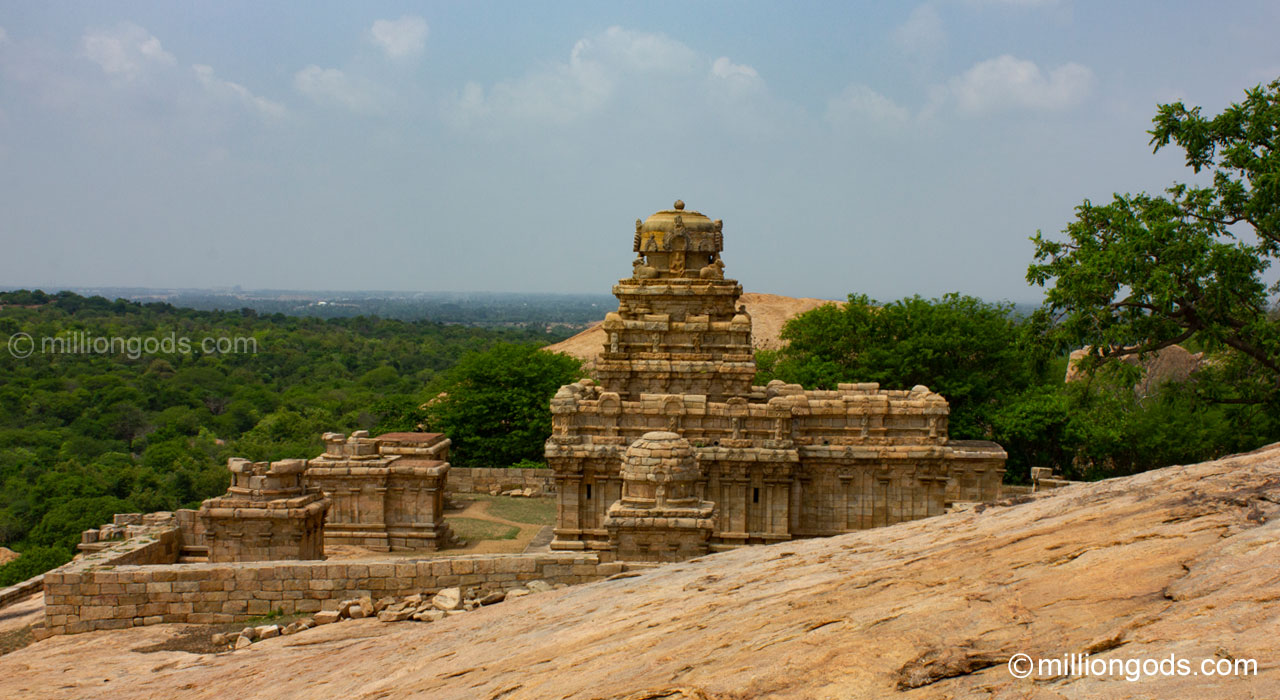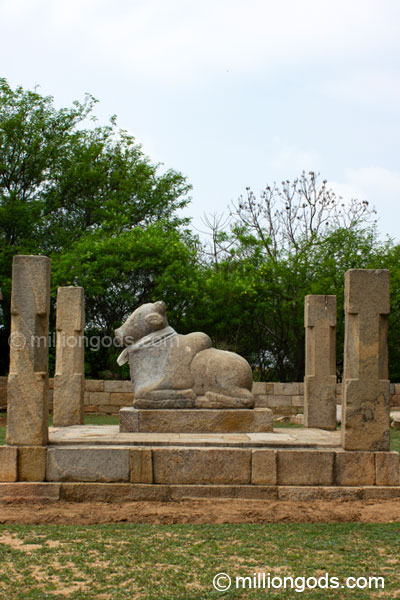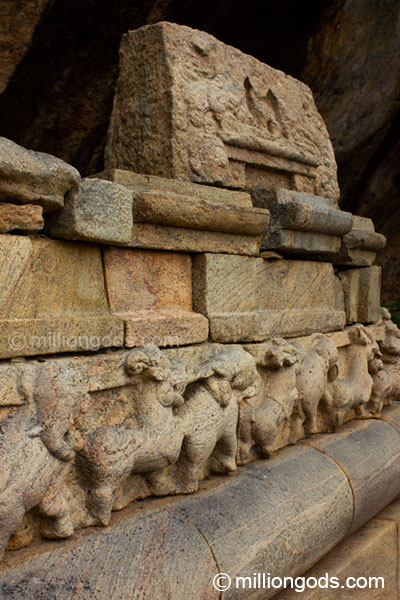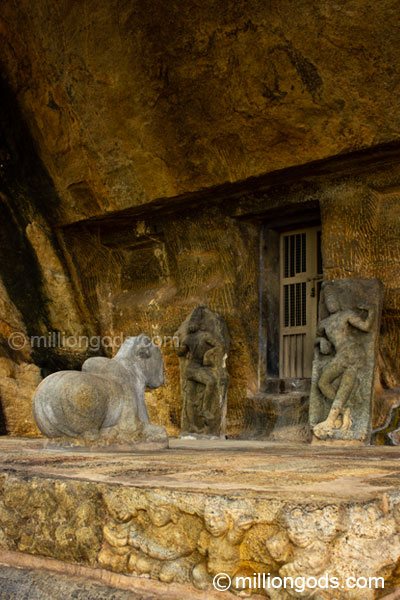Shiva, facing west
Vijayalaya Choleeswaram Narthamalai
Vijayalaya Choleeswaram, Narthamalai
Saivite Temples, Pudhukottai District

God
Goddess
None
Other Deities
None installed
Vijayalaya Choleeswaram Narthamalai is a west-facing the temple with a Shiva Lingam installed. In the Ardha Mandapam are remnants of some paintings, mostly lost, probably belonging to the Nayak Period (17th Century CE). On either of the west facing entrance to the sanctum sanctorum are two beautiful Dwarapalakas with sacred threads and a lion-faced bracelet. The one in the north has an inscription below. The sanctum sanctorum has two walls, probably the result of renovation and has a narrow passage in between. Opposite the main shrine is the Nandi Mandapam and a large Nandi. There were originally eight more shrines around the main temple in the Prakaram, one in each direction. Six of them are now present and all of them are at various stages of damage and renovation. These eight subsidiary shrines around the central temple, is referred to as Ashta-Parivara pattern. The shrines for the deities and the directions are as follows – Chandra in the east, Surya in the south-east, Sapta-Madar in the south, Ganesha in the south-west, Subramanya in the west, Jyestha in the north-west, Chandikeswara in the north and Bhairava in the north-east.
On the north side of the temple a little way away is a pond in the hill that is said to have water from a spring most of the time. Under the water in a small cave is a Shiva Lingam. This pond is called Talai-Aruvi-Singam Sunai. The Shiva Lingam in this shrine is called Jurahareshwara. There is said to be an inscription beside it. These can be seen only when the water level is low. On top of this pond is a shrine which presently houses a Vinayaka Idol. There is a large waterbody at the base of the hill on the north east side which is called Animadha Eri.
On the west side of the Vijayalaya Choleeswaram Narthamalai temple there are 2 cave temples on the huge rock face. One of them has 12 life sized carvings of Lord Vishnu on the mandapam walls outside the cave. The cave itself has indications of having a Shiva Lingam in it. This is probably the largest cave temple in the Pudukkottai region. The temple is referred as Thirumerkoil and Patinenpumi-vinnagar and the lord as Karumanikkattalvar in its inscriptions. The front façade of the cave is supported on two pillars and two pilasters forming three aisles, central aisle having more width than the side aisles. They all are shown standing over a lotus pedestal. They carry a sankha (conch) and a chakra (discus) in their rear hands and one front hand is in abhaya-mudra while resting on waist. The twelve Vishnu images may represent dvadash (twelve) adityas who are said to be associated with Vishnu. It could also represent twelve forms of Vishnu – Kesava, Narayana, Madhava, Govinda, Vishnu, Madhusudana, Trivikrama, Vamana, Sridhara, Risikesha, Padmanabha and Damodara. Above this facade is a cornice, devoid of any ornamentation such as kudu-arches. Outside, on the base of this cave temple are exquisite Yaali carvings along with Elephants and Purusha Mirugam (Sphinx). Of particular interest would be a series of 3 elephants with natural movement and a head-on elephant. Just below these are some inscriptions. There is a disputed point as this excavation is also said to have originally been a Jain cave temple and the Vishnu idols were carved over the existing carvings later. There is also a suggestion that the shrine was dedicated to Surya and gained prominence during the rule of the Chola King Kulothunga I (1070-1120 CE).
The name Narthamalai of this place is derived from Nagarattarmalai, since this area was the residence of Nagarattars, a mercantile community. It was a sprawling and flourshing town in olden days. It was also an ancient and important Jain center as evident from the presence of rock-cut beds at its many hills including Melamalai and Aluruttimalai.
Holy Water (Theertham) – Pond north of the temple
Sacred Tree (Sthala Vriksham) – No information



History
An inscription found below the Dwarapala image at Vijayalaya Choleeswaram Narthamalai, mentions that the original temple was constructed by Sembudi (or Sattan Pudi or Cattan Pudi) alias Ilangodi-Araiyar. It was damaged after heavy rains and was renovated by Mallan Viduman alias Tennavan Tamiladiariayan. An another record of Mallan Viduman is found near the sluice of the tank nearby. Based on inscriptions elsewhere Ilangodi Araiyar could either be a contemporary of Pallava Nandivarman III (825-850 CE) or his predecessor Dantivarman (775-825 CE). S R Balasubrahmanyam holds that Sembudi Ilangovadi Araiyar belonged to the age of Vijayalaya Chola (Reign:c.847 – 871 CE), and that he was the builder of the temple, that lighting and rains destroyed the Vijayalaya Choleeswaram Narthamalai temple within a few years of its consecration and that it was reconstructed very probably with all its old materials and in the same form and style by Mallan Viduman alias Tennavan Tamiladi Ariayan – perhaps this too before the close of the reign of Vijayalaya.
Barrett writes, “Were it not for the Pandya inscriptions, which is well over three hundred years later than the latest date which can be put to the construction of the temple, no one, I think, would see this remarkable monument as representative of the Early Chola style of architecture, to which it bears no resemblance in plan and elevation and very little in detail.” In the light of its architecture and style, Barrett dates the temple towards the middle of the ninth century CE and considers it as a Mutharaiyar monument.
K G Krishnan, who has worked extensively in settling the questions around the chronology of the Mutharaiyars considers Cattan (Sattan) Pudi and Chattan (Sattan) Paliyili as the two sons of Videlvidugu Mutharaiyar alias Kuvavan Cattan (Sattan), the latter is mentioned in the Malayadipatti Shiva cave temple inscription. If this is accepted, then this structural temple becomes coeval with the Shiva cave temple here, both datable to around 850 CE and conceived by the two brothers mentioned above. Mutharaiyars, being a small dynasty, it is suggested that this specific temple has influences from the Pallavas or the Pandyas as these were the only two major dynasties during that time. K V Soundara Rajan tells that this temple is the earliest ashta-parivara temple showing early Pandya influence and it is definitely pre-Vijayalaya structure datable to mid-ninth century CE. Venkataraga Raju opines that the early Chola architecture was highly influenced by their predecessor, the Pallavas. And the temple at Narthamalai is a good example where its outward appearance resemble to a large extent those of the Pallavas.
On the west side rock face at Vijayalaya Choleeswaram Narthamalai, is the Pazhiyili Ishwaram Cave Temple excavated around 850 CE by Saathan Pazhiyili. His daughter later expanded this cave shrine with a mukha-mandapa, a Nandi-mandapa and a balipitha in 875-76 CE. An inscription here refers to the seventh regnal year of the Pallava King Nrpatungavarman (869-882 CE).
S R Balasubrahmanyam mentions that the Vishnu cave temple was known as Samana-Kugadu and the hill as Samana-Malai suggesting its Jain association and the cave was originally meant for the Jains and excavated around seventh century CE. K R Venkatarama Ayyar suggests that the placement of the inscription at the base of the adhishthana suggests that it could not been placed after construction. And this confirms that this cave temple was converted from a Jain shrine to a Vishnu shrine. Aschwin Lippe, while reviewing Barrett’s work, suggests that the Vishnu cave can be dated in the first half of the 9th century CE, or perhaps 850 CE. On the moulded basement in front of the rock-cut Vishnu shrine is an inscription that refers to the 45th regnal year of Chola King Kulothunga I (1070-1120 CE), corresponding to 1114-15 CE mentions a deed for daily food offerings to the god Karumanikkalvar of the Tirumerkoyil temple of the city by the members of the Nagaram of Telungakulakalapuram in Annavayil-kurram of Irattappadi-kondachola-valanadu.
On the rock to the north of the Vishnu cave temple an inscription refers to the 12th regnal year of the Pandya king Sundara Pandya I (1216-1238 CE), corresponding 1227-78 CE records setting up of images of Patinenbhumi-vinnagar-emberuman and his consort in the Tirumerkoyil temple at Telingakulakalapuram alias Kulottunga-cholapattinam and gift of land for daily food offerings and other daily requirements. On the same rock another inscription corresponding 1227-78 CE records provision for conducting festivals in the temple of Vijayalaya-Cholisvaramudaiyar at the town by the nagaram of Kulottungachola-pattinam.
In inscriptions Narthamalai is referred as Annavayil-kurram, a sub-division in Keralantaka-valanadu alias Konadu during the reign of the Chola King Rajaraja I (985-1014 CE). Later the region is referred as Irattappadi-kondachola-valanadu during the reign of the Chola King Kulothunga I (1070-1120 CE). The region is referred to as Telingakulakalapuram alias Kulottungacholapattinam during the Pandya rule.
Legend
It is believed that these hills are fragments of the Sanjeevani hill that was taken to Sri Lanka by Hanuman to restore the life of Lakshmana. When Hanuman threw it back from Lanka, fragments of the same are believed to have landed here around Vijayalaya Choleeswaram Narthamalai. The name, Narthamalai, in some Puranas, is said to have originated from Sage Narada and calls it Naradamalai. An image playing on Veena (string instrument) found in many parts of the village was thought as the image of Sage Narada and thus the town came to be known as Naradamalai.
Directions
Vijayalaya Choleeswaram Narthamalai is about 15 kilometers north of Pudukottai on the road leading to Thiruchirapalli. This place is called Narthamalai and is before Keeranur. Important Jain Beds and other historic temples are in this area. All are nearby and you can combine them in a single trip – Vijalaya Choleeswaram, Kadambar Koil, Aaluruttimalai Jain beds, Rock Art and a few more.
Stay and Food
None locally. Closest would be Thiruchirapalli and Pudukottai.
